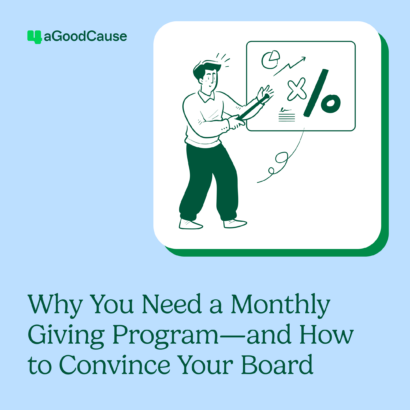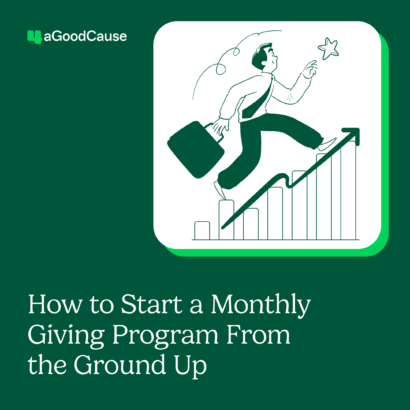The most successful fundraising campaigns focus on identifying the right prospective donors. Who are they? Those who are not only able to make a significant contribution but also deeply care about your organization.
Finding the “right” prospective donors can prove challenging. This article is here to help reduce those challenges.
To aid your team in finding top-tier prospects, we’re going to look at the five factors that have the strongest bearing on future giving.
- Past Charitable Giving to Your Organization
- Past Charitable Giving to Other Nonprofit Organizations
- Involvement in Nonprofits as a Foundation Trustee or Director
- Political Giving
- Real Estate Ownership
Now, let’s discuss each point in detail.
1. Past Charitable Giving to Your Organization
Loyal donors are immensely valuable. Donors who have already given once are far more likely to give again than your average prospects are.
Far too many organizations overlook the value in retaining donors and expend too much energy on acquisition.
While new donor acquisition is critical, you don’t want to miss out on the upgrade possibilities within your own donor pool!
The best way to analyze previous giving is through the application of an RFM score.
An RFM score stands for:
- Recency of giving: The last time the supporter made a donation.
- Frequency of giving: The number of times a supporter has given.
- Monetary contribution: The total amount the supporter has donated.
Think of the RFM score as a way to internally assess how strong the relationship is between your nonprofit and your existing donors.
Once you’ve evaluated donors against those three categories, you can rank them and prioritize outreach accordingly.
All three factors deserve equal consideration. You want a complete picture of your donors as you map out upgrade opportunities.
For instance, according to the DonorSearch guide, “78% of supporters who donated planned gifts had already given the nonprofit named in their will 15 or more gifts during their lifetime.”
In other words, a strong history with your organization indicates a strong future.
2. Past Charitable Giving to Other Nonprofit Organizations
Second only to past giving to your nonprofit, previous giving to other organizations is a powerful predictor of future giving.
Those who have a demonstrated history of charitable giving are logically more likely to give than others who don’t.
Let’s look at the data:
- Individuals who have made a gift of over $100k to a nonprofit are 32 times more likely to make a charitable donation elsewhere.
- Individuals who have made a gift of $50k – $100k to a nonprofit are 25 times more likely to make a charitable donation elsewhere.
- Individuals who have made a gift of $10k – $25k to a nonprofit are 10 times more likely to make a charitable donation elsewhere.
- Individuals who have made a gift of $5k – $10k to a nonprofit are 5 times more likely to make a charitable donation elsewhere.
As Adam Weinger of Double the Donation has said, “Individuals can be a powerful force for good. Whether they donate ten dollars a month for a year or give $5,000 with one check, individual donors have the potential to be the best source of revenue for your nonprofit.”
Fundraising always finds it way back to the individual, and as the data shows, individuals who have already given are much more likely to do so again.
Take Lloyd Claycomb, for example. As a repeat major donor, Claycomb and his wife, “Have raised and donated hundreds of thousands of dollars in an effort to educate and spread awareness of the autism spectrum disorder.”
He has found a cause he cares deeply about and has the financial ability to support those philanthropic interests. If you’re actively looking for it, you’ll see that pattern over and over again with your own donors and prospects.
Trust the data. If you want to identify candidates who are likely to give, you should start by analyzing their giving histories.
3. Involvement in Nonprofits as a Foundation Trustee or Director
According to our research of charitable giving to over 400 nonprofits, participation as a foundation trustee or nonprofit director is a more powerful signal of future philanthropy than any wealth indicator.
How come?
Well, first and foremost, these prospects have an existing understanding of charitable work and the effort that goes into fundraising.
When you’re making your pitch, they are more likely to already know where you’re coming from and can better predict where you’d like to go than a random prospect would.
You’re probably already tapping into your donors’ emotions as you make your fundraising case. Imagine how much more efficient your process could be if you were able to remain focused on the emotion and know that the prospect already gets the logistical side of things.
In other words, their previous experience with your world makes cultivation far easier and more direct. That, in turn, makes solicitation and stewardship easier.
Plus, there are more benefits to come once you’ve actually acquired a donation from a foundation trustee or nonprofit director. At that point, you’ll have something very valuable in your arsenal: a well-connected donor.
Any foundation trustee or board member is sure to have connections to other members of their foundation or nonprofit board.
Use those connections!
Often times, they’ll be major gift prospects in waiting. Building a relationship with a high-quality fundraising prospect can be quite challenging. They’re busy people who take great care to decide where, when, and how they spend their money.
The best thing you can do is start the relationship off with an established level of trust. And how do you build that trust? You get introduced by one of your donors who also happens to be a fellow board member or foundation trustee!
4. Political Giving
Political giving is an interesting predictor to study up on.
In fact, one lifetime FEC gift of $250 puts your constituent in the top 6% of the United States population. Even more, a lifetime FEC gift of $1,000 puts your constituent into the top one-tenth of one percent.
Political giving’s predictive power is three-fold.
First, if you know how much someone has given politically, you can get a better sense for their average gift size. Although political giving is different than making charitable donations, it’s still similar enough to provide a predictive angle.
Second, political giving demonstrates someone’s willingness to make a donation to a cause they care about. Use your communications and your marketing to sway political donors to feel the same about your cause as they do about the campaigns they’ve donated to.
Third, the candidates and campaigns your prospective donors have contributed to can tell you a lot about their likelihood of giving to your organization. If someone has regularly donated to a candidate who supports much of the work you do, that prospect’s philanthropic views are likely in line with your cause and by extension, your nonprofit.
As with many of these other indicators, the proof is in the data:
- An individual who has given at least $2,500 in his/her lifetime to federal political campaigns is 14 times more likely to give a philanthropic donation than someone who has not.
- An individual who has given at least $500 in his/her lifetime to federal political campaigns is 5 times more likely to give a philanthropic donation than someone who has not.
So how do you find this data? By searching the FEC.gov website, you can find free records of political giving by typing in your donors’ names.
Go forth and get to searching!
5. Real Estate Ownership
Real estate ownership is the only definitive wealth marker to make this list.
Why is that?
Although wealth needs to be considered for the big picture, — especially with fundraising for major gifts, planned gifts, and the like — it’s not going to drive someone to give.
Just because someone has the money to donate, that doesn’t mean that they’re going to donate. You need to lead with philanthropy.
That being said, there is a time and a place for wealth screening, and real estate ownership must be a part of that conversation.
We’ve found the following correlations:
- An individual who owns $2+ million worth of real estate is 17 times more likely to give philanthropically than the average person is.
- An individual who owns $1-2 million worth of real estate is 4 times more likely to give philanthropically than the average person is.
- An individual that owns $750k -1 million worth of real estate is 2 times more likely to give philanthropically than the average person is.
As you can see from the data, real estate ownership goes beyond wealth. It does double duty as a philanthropic indicator.
And, as an added bonus, you can use real estate ownership and property records to backtrack a donor’s giving capacity.
For a sample exercise, let’s think about how helpful knowledge of real estate ownership could be for a capital campaign.
During the quiet phase of a capital campaign, you’re looking to secure major gifts (learn more here: http://www.donorsearch.net/capital-campaigns-guide/).
And since capital campaigns tend to be brick-and-mortar style fundraisers with direct community impact, you’d also want to be reaching out to those directly involved in your community.
Enter real estate holdings.
With information on real estate holdings, you can figure out who qualifies for major gifts and who lives within your community and would most directly be impacted by your campaign.
In conclusion, real estate ownership is a giving indicator with multiple predictive layers.
How can nonprofits uncover these indicators?
Looking into these indicators should start with prospect research. A prospect screening, whether performed by a screening company or some other means, will assist you in finding all of this information about your donors.
Don’t hesitate to analyze a wide spectrum of your supporters from those who are active on your social sites to those who are big spenders at your annual auction. You never know which unturned stone will reveal a strong major gift prospect.
Uncovering this information goes beyond prospect identification, too!
You can leverage what you find to map out the ideal fundraising strategy, incorporating your newfound knowledge into your cultivation, solicitation, and stewardship plans.
What are you waiting for? It’s time to get to researching!



